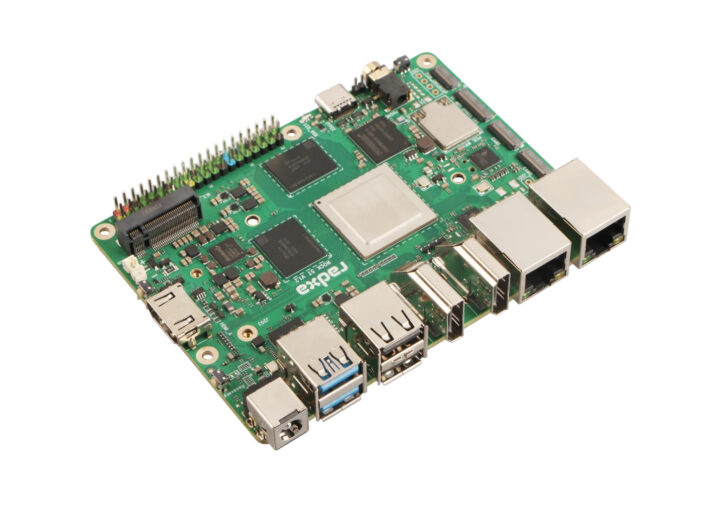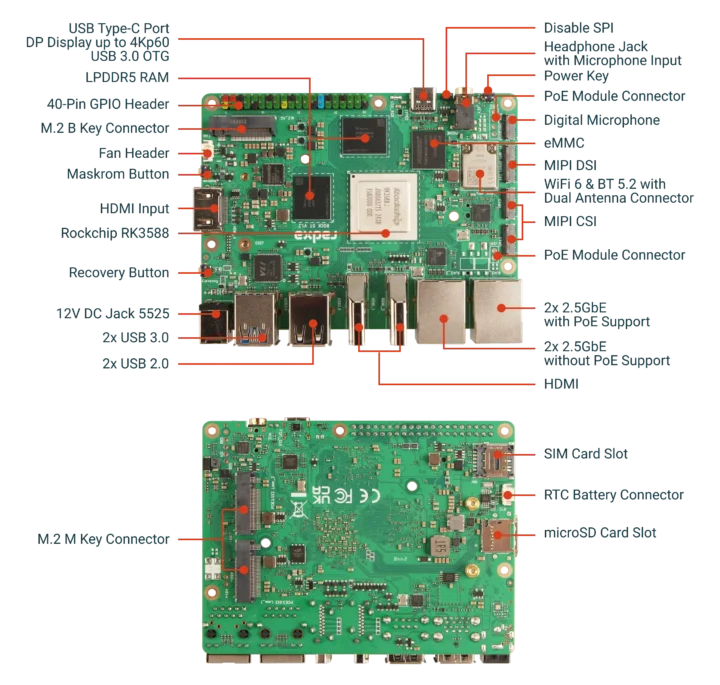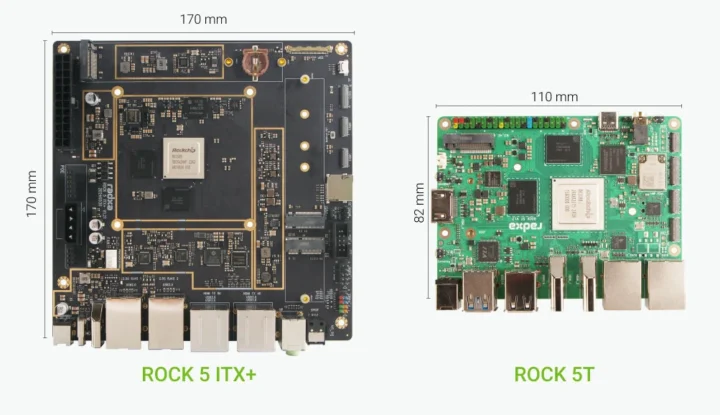Radxa ROCK 5T is yet another Rockchip RK3588 SBC whose main selling point is to pack most features of the ROCK 5 ITX mini-ITX motherboard (170x170mm) into a much smaller 110x80mm board.
The board features up to 32GB RAM, M.2 2280 sockets for NVMe SSDs, four independent display outputs via HDMI, USB-C, and MIPI DSI, HDMI input and camera interfaces, two 2.5GbE RJ45 jacks, on-board WiFi 6/6E and Bluetooth 5.x, and an M.2 Key-B socket for cellular connectivity.
Radxa ROCK 5T specifications: (with differences highlighted in bold or strikethrough)
- SoC – Rockchip RK3588 or RK3588J (industrial grade)
- CPU – Octa-core processor with four Cortex-A76 cores @ up to 2.2 GHz (industrial) / 2.4 GHz (commercial), four Cortex-A55 cores @ up to 1.8 GHz
- GPU – Arm Mali G610MC4 GPU
- VPU
- 8Kp60 10-bit H.265 / VP9 / AVS2 / AV1 decoder, 8Kp30 H.264 decoder
- 8Kp30 H.265 / H.264 encoder
- AI accelerator – 6 TOPS NPU
- System Memory – 4GB, 8GB, 16GB, 24GB, or 32GB 64-bit LPDDR5
- Storage
- 2x M.2 2280 sockets for NVMe SSD (PCIe 3.0 x2)
- MicroSD card socket
4x SATA ports- Optional onboard 16GB to 128GB eMMC flash
- Optional SPI Flash for Bootloader
- Video Output
- 2x HDMI port, one up to 8Kp60, the other up to 4Kp60
- 1x USB-C with DisplayPort Alt. mode up to 4Kp60
- 1x 4-lane MIPI DSI connectors
1x eDP with touch panel support- Up to four independent displays supported up to 4K + 4K + 4K + 2K resolutions or 8K + 4K + 2K resolutions (3x displays)
- Video Input
- HDMI input up to 4Kp60
- 2x 4-lane MIPI CSI connectors (also configurable as 4x 2-lane MIPI CSI)
- Audio
- 3.5mm headphone jack with microphone input
- Digital microphone via FPC connector
3.5mm microphone JackFront audio headerOptical S/PDIF output
- Networking
- 2x 2.5 Gbps Ethernet RJ45 ports, one with optional PoE support
- WiFi
- Commercial (RK3588) – Wi-Fi 6 & Bluetooth 5.2 module with two IPEX antenna connectors
- Industrial (RK3588J) – Wi-Fi 6E & Bluetooth 5.3 module with two IPEX antenna connectors
M.2 E-Key socket for WiFi 6 module
- Cellular – M.2 Key-B 3042 socket and Nano SIM card slot for 4G LTE/5G connectivity
- USB
- 2x USB 3.1 Gen 1 Type-A ports
- 2x USB 2.0 Type-A ports
- 1x USB 3.1 Gen 1 OTG/Host Type-C port
2x USB 2.0 via front USB header
- Expansion – 40-pin (mostly) Raspberry Pi-compatible GPIO header
- Misc
- Power and Recovery buttons
- RGB LED for power indicator, system status, and user
- PWM fan connector
- RTC battery connector
RTC socket (CR1220 battery)Front Panel header for Power Button / Reset Button / Status LED
- Power Supply
- 12V DC power barrel jack (55x25mm)
Standard 24-pin ATX power supply interface- PoE Header (additional PoE module required)
- Dimensions – 110 x 80mm
170 x 170mm (Mini-ITX form factor) - Temperature Range
- Commercial (RK3588)Recommended – 0 to 60°C
- Industrial (RK3588J) – TBD, up to -40 to +85°C
- Compliance – FCC/CE
One of the main differences is the ROCK 5T is offered with both commercial and industrial temperature grades, while the ROCK 5 ITX would only be specified for commercial applications. Some features on the mini-ITX motherboard are also gone mostly for good reasons: the 24-pin ATX connector, the front panel header, the four SATA connectors, two of the four USB 3.1 Type-A ports, and the M.2 Key-E socket for wireless.
The latter can easily be explained since the company offers the ROCK 5T SBC with much more compact soldered-on WiFi 6/6E and Bluetooth 5.x wireless modules. The RTC battery socket is also gone, but there’s a 2-pin connector for the battery instead. The ROCK 5T also gains a 24GB memory option that I didn’t see on the ROCK 5 ITX, a 40-pin GPIO header compatible with most Raspberry Pi HATs, as well as an M.2 Key-B socket and Nano SIM card for cellular connectivity.
I was initially surprised by the comparison photo above since my ROCK 5 ITX board comes with four SATA ports, and it’s completely gone. It turns out Radxa removed those on the ROCK 5 ITX+ based on feedback from the community, so the ROCK 5T compares more closely to the new ROCK 5 ITX+ than the original ROCK 5 ITX.
The software will be about the same and we’re told the Debian-based Radxa OS and Android are supported on the ROCK 5T. You’ll find more details on the documentation website and the product page. The commercial version of the ROCK 5T SBC can be purchased on Arace Tech for $139.50 (16GB RAM) or $219.50 (32GB RAM). If you’ve never heard about the ROCK 5 ITX+, it’s listed on AliExpress and you’ll find more information on the product page.
The ROCK 5T is also very similar to the ROCK 5B+ but it adds one extra 2.5GbE port, PoE is implemented through an extra PoE module instead of a HAT, and it relies on a 12V DC power jack instead of a USB-C port. However, it won’t be compatible with ROCK 5B/5B+ cases because it’s slightly longer and wider.

Jean-Luc started CNX Software in 2010 as a part-time endeavor, before quitting his job as a software engineering manager, and starting to write daily news, and reviews full time later in 2011.
Support CNX Software! Donate via cryptocurrencies, become a Patron on Patreon, or purchase goods on Amazon or Aliexpress








